最新turn的用法总结
turn的用法总结大全

turn的用法总结大全turn 是一个非常常用的词,在不同的语境中有不同的用法。
下面是 turn 的一些常见用法总结:1. 转动,转向:- She turned the key in the lock.(她把钥匙插入锁里。
)- The car turned left at the intersection.(汽车在十字路口向左转。
)- The river turns sharply at this point.(河流在这个地方急转弯。
)2. 变成,成为:- The caterpillar will turn into a butterfly.(毛毛虫会变成蝴蝶。
)- The weather turned cold overnight.(天气在一夜之间变冷了。
)- He turned into a successful businessman.(他成为了一位成功的商人。
)3. 翻转,翻身:- She turned the book over to see the back cover.(她把书翻过来看封底。
)- The gymnast turned gracefully in mid-air.(体操运动员在半空中优雅地翻转。
)4. 改变方向,转变:- The project turned out to be a success.(这个项目结果证明是成功的。
)- His life took a turn for the better.(他的生活有了好转。
)- The discussion suddenly turned to a different topic.(讨论突然转向了另一个话题。
)5. 轮到(某人做某事):- It's your turn to do the dishes.(轮到你洗碗了。
)- Each team will take turns to play.(每个队轮流比赛。
)6. 开始做,转向某事:- She turned to writing after retiring from her job.(她离职后转而从事写作。
turn短语总结

turn短语总结近年来,英语学习已成为越来越多人的关注点。
而作为英语学习的重要一环,短语的掌握显得尤为重要。
本文将就英语中常用的短语“turn”进行总结,并给出相应的例句以加深理解。
一、常用短语1. turn on:打开。
例如:Please turn on the lights.(请把灯打开。
)2. turn off:关闭。
例如:Don't forget to turn off the TV before leaving.(离开之前别忘了把电视机关掉。
)3. turn up:出现,到场。
例如:She didn't turn up at the meeting yesterday.(她昨天没有出席会议。
)4. turn down:拒绝。
例如:He turned down the job offer because of the low salary.(由于薪水过低,他拒绝了这份工作机会。
)5. turn over:翻转。
例如:Can you help me turn over the pancakes?(你能帮我把煎饼翻一下吗?)6. turn around:转身。
例如:She turned around and walked away without saying a word.(她转身走开,一句话也没说。
)7. turn into:变成。
例如:The caterpillar will eventually turn into a butterfly.(毛毛虫最后会变成蝴蝶。
)8. turn out:结果是。
例如:It turned out that he wasright all along.(结果证明他一直是对的。
)9. turn to:求助。
例如:When in doubt, turn to a trusted friend for advice.(当有疑问时,求助一位可信的朋友寻求建议。
关于turn的常见短语用法
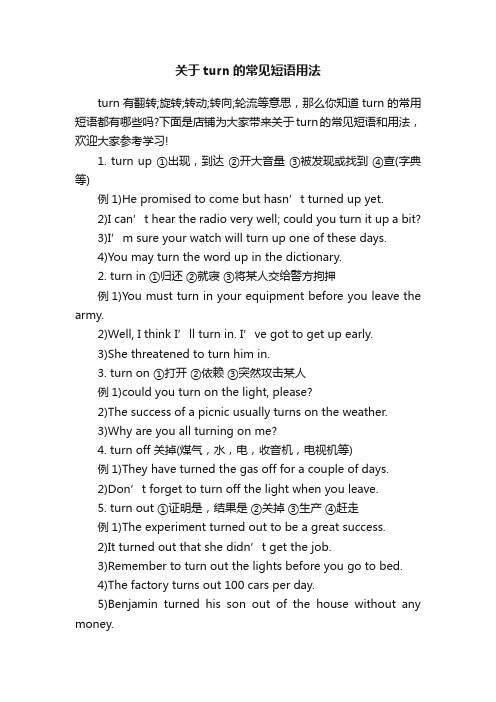
关于turn的常见短语用法turn有翻转;旋转;转动;转向;轮流等意思,那么你知道turn的常用短语都有哪些吗?下面是店铺为大家带来关于turn的常见短语和用法,欢迎大家参考学习!1. turn up ①出现,到达②开大音量③被发现或找到④查(字典等)例1)He promised to come but hasn’t turned up yet.2)I can’t hear the radio very well; could you turn it up a bit?3)I’m sure your watch will turn up one of these days.4)You may turn the word up in the dictionary.2. turn in ①归还②就寝③将某人交给警方拘押例1)You must turn in your equipment before you leave the army.2)Well, I think I’ll turn in. I’ve got to get up early.3)She threatened to turn him in.3. turn on ①打开②依赖③突然攻击某人例1)could you turn on the light, please?2)The success of a picnic usually turns on the weather.3)Why are you all turning on me?4. turn off 关掉(煤气,水,电,收音机,电视机等)例1)They have turned the gas off for a couple of days.2)Don’t forget to turn off the light when you leave.5. turn out ①证明是,结果是②关掉③生产④赶走例1)The experiment turned out to be a great success.2)It turned out that she didn’t get the job.3)Remember to turn out the lights before you go to bed.4)The factory turns out 100 cars per day.5)Benjamin turned his son out of the house without any money.6. turn against 背叛例1)She will never turn against her country.2)She turned against her old friend.7. turn down ①关小②拒绝例1)Can you turn the TV down? I’m trying to get some sleep.2)He tried to join the army but was turned down because of poor health.8. turn into 把……变成,译成例1)You’ll never turn me into a salesman.2)Turn the following sentences into Chinese, please.9. turn to 翻到,求助于例1)Please turn to page10.2)The child turned to its mother for comfort. 3)turn to a dictionary (look up the words in the dictionary)10. turn over ①翻身,翻转②移交,交付例1)She turned over and went to sleep.2)The car turned right over.11. turn (a)round ①绕着……转②面向另一方向例1)The earth turns around / round the sun.2)Turn around / round and let me look at your back.12. turn away ①转过脸,不面对或不再看②拒绝帮助,拒绝某人进入某处例1)She turned away in horror at the sight of so much blood.2)A doctor can’t turn away a dying man.3)Hundreds of people had to be turned away from the stadium.13. turn back 原路返回,往回走例1) The weather became so bad that they had to turn back.2)We were turned back at the border because of the fighting.14. take turns (at) doing sth. / to do sth. 依次,轮流做某事例1)We took turns (at) doing the driving on the way up to Canada.2)You’ll have to take turns being captain of the team.15. in turn ①结果②依次例1)Interest rates were cut, and in turn, share prices rose.2)He asked each of us in turn to describe how alcohol had affected our lives.16. by turns 依次例1)Let’s drive the car by turns.2)We did the work by turns.17. at every turn 经常地,每次例1)I kept meeting him at every turn.turn的用法1:turn的基本意思是“旋转,转动”,指做圆周运动或弧形运动。
turn的用法总结大全

turn的用法总结大全turn的用法你知道多少,今天给大家带来turn的用法,希望能够帮助到大家,下面就和大家分享,来欣赏一下吧。
turn的用法总结大全turn的意思v. 使转动,旋转,转身,翻转n. 转动,转向,转弯处,转变变形:过去式: turned; 现在分词:turning; 过去分词:turned;turn用法turn可以用作动词turn的基本意思是“旋转,转动”,指做圆周运动或弧形运动。
引申可作“翻转”“开始涨或落”“瞄准,指向”“使…向某方向走”“达到,超过”“表演”“(使)变酸”“(使)不适,作呕,恶心”“翻译”“赶走”“考虑”“用车床加工,车削”等解。
作“改变”解时,指彻底改变,以至面目全非,且常用于朝坏的方向改变。
turn可用作及物动词,也可用作不及物动词。
用作及物动词时,可接名词或代词作宾语,也可接以形容词充当补足语的复合宾语。
turn还可用作系动词,意为“成为,变成”,后接名词或形容词作表语,用作表语的名词须用零冠词。
turn用作动词的用法例句The turbulence caused the plane to turn over.空气的激流导致飞机翻转。
Men carried corpses in blankets away from the scene and a dozen others tried to turn over a car with two bodies beneath.搬运工把用毯子盖着的尸体搬离现场,另有十多人试图翻转汽车,搬出下面的两具尸体。
At each turn the screw goes in further.每一次旋转都使螺丝钉更向里进。
turn可以用作名词turn用作名词的基本意思是“转动,旋转”,指使某人或某物转动的行为或某物自己旋转的动作,是可数名词。
turn也可表示“方向的改变,转折,转折点”“转弯处”,引申可作“时间上的转折点,交替时期”解,是可数名词。
turn的用法及短语

turn的用法及短语一、turn 的基本用法Turn 是一个常用的英语动词,有许多不同的用法和短语。
下面将介绍 turn 的基本用法,帮助大家更好地理解和运用该动词。
1. 作为动词,turn 可以表示“转动”,指物体或身体在某个方向上进行移动或改变。
例如:- The car turned the corner swiftly.(汽车迅速转过了拐角。
)- The child turned his head to look at the noise.(孩子转过头去看着声音的来源。
)2. Turn 还可以表示“转变”或“改变”状态或方向。
例如:- After years of hard work, he finally turned his life around.(经过多年的努力,他终于扭转了自己的生活。
)- The weather suddenly turned cold in the evening.(天气在晚上突然变冷了。
)3. 当 turn 后接名词时,常表示“使成为”或“使变得”。
例如:- He turned his hobby into a successful business.(他把自己的爱好发展成了一个成功的事业。
)- She turned her dream into reality through hard work.(她通过努力工作将梦想变成现实。
)4. Turn 还可指某人打开某物、关上某物或调整某物的开启状态。
例如:- Can you please turn off the lights before leaving the room?(你离开房间前能把灯关掉吗?)- I turned on the TV to watch the news.(我打开电视看新闻。
)二、turn 的常用短语除了基本用法外,turn 还有许多常见的短语,下面将介绍其中一些。
1. turn up: 意为“出现”或“到达”。
turn的用法总结大全

turn的用法总结大全turn的用法总结大全turn的用法你知道多少,今天给大家带来turn的用法,希望能够帮助到大家,下面就和大家分享,来欣赏一下吧。
turn的用法总结大全turn的意思v. 使转动,旋转,转身,翻转n. 转动,转向,转弯处,转变变形:过去式: turned; 现在分词:turning; 过去分词:turned;turn用法turn可以用作动词turn的基本意思是“旋转,转动”,指做圆周运动或弧形运动。
引申可作“翻转”“开始涨或落”“瞄准,指向”“使…向某方向走”“达到,超过”“表演”“(使)变酸”“(使)不适,作呕,恶心”“翻译”“赶走”“考虑”“用车床加工,车削”等解。
作“改变”解时,指彻底改变,以至面目全非,且常用于朝坏的方向改变。
turn可用作及物动词,也可用作不及物动词。
用作及物动词时,可接名词或代词作宾语,也可接以形容词充当补足语的复合宾语。
turn还可用作系动词,意为“成为,变成”,后接名词或形容词作表语,用作表语的名词须用零冠词。
turn用作动词的用法例句The turbulence caused the plane to turn over.空气的激流导致飞机翻转。
Men carried corpses in blankets away from the scene and a dozen others tried to turn over a car with two bodies beneath.搬运工把用毯子盖着的尸体搬离现场,另有十多人试图翻转汽车,搬出下面的两具尸体。
At each turn the screw goes in further.每一次旋转都使螺丝钉更向里进。
turn可以用作名词turn用作名词的基本意思是“转动,旋转”,指使某人或某物转动的行为或某物自己旋转的动作,是可数名词。
turn也可表示“方向的改变,转折,转折点”“转弯处”,引申可作“时间上的转折点,交替时期”解,是可数名词。
turn的用法及固定搭配
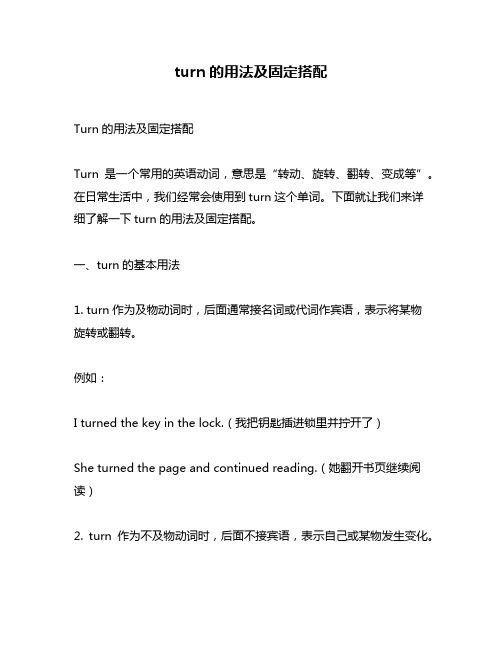
turn的用法及固定搭配Turn的用法及固定搭配Turn是一个常用的英语动词,意思是“转动、旋转、翻转、变成等”。
在日常生活中,我们经常会使用到turn这个单词。
下面就让我们来详细了解一下turn的用法及固定搭配。
一、turn的基本用法1. turn作为及物动词时,后面通常接名词或代词作宾语,表示将某物旋转或翻转。
例如:I turned the key in the lock.(我把钥匙插进锁里并拧开了)She turned the page and continued reading.(她翻开书页继续阅读)2. turn作为不及物动词时,后面不接宾语,表示自己或某物发生变化。
例如:The weather has turned cold.(天气变冷了)He turned pale when he heard the news.(听到这个消息他脸色苍白了)3. turn还可以表示“改变方向”、“前往”等意思。
例如:Turn left at the next intersection.(在下一个十字路口向左拐)He turned to me for help.(他向我求助)4. turn还可以表示“成为”、“变成”的意思。
例如:She has turned into a beautiful young lady. (她已经成为了一位美丽的年轻女子)The caterpillar turned into a butterfly.(毛毛虫变成了蝴蝶)5. turn还可以表示“调整”、“控制”等意思。
例如:Can you turn down the music a little bit?(你能把音乐调小一点吗?)He turned his attention to the new project.(他把注意力转移到了新项目上)6. turn还可以表示“翻译”、“转录”等意思。
例如:Could you please turn this article into English?(你能把这篇文章翻译成英语吗?)She turned his speech into shorthand.(她将他的演讲记录在速记本上)二、turn的固定搭配1. turn around意思是“转过身来”,也可表示“改变方向”。
turn的用法及固定搭配短语
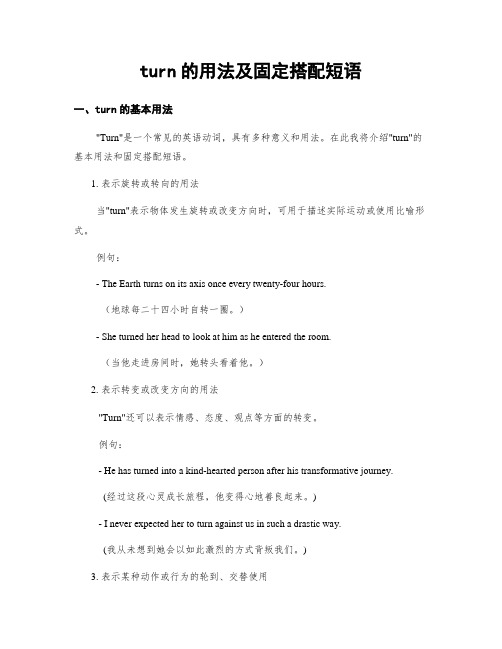
turn的用法及固定搭配短语一、turn的基本用法"Turn"是一个常见的英语动词,具有多种意义和用法。
在此我将介绍"turn"的基本用法和固定搭配短语。
1. 表示旋转或转向的用法当"turn"表示物体发生旋转或改变方向时,可用于描述实际运动或使用比喻形式。
例句:- The Earth turns on its axis once every twenty-four hours.(地球每二十四小时自转一圈。
)- She turned her head to look at him as he entered the room.(当他走进房间时,她转头看着他。
)2. 表示转变或改变方向的用法"Turn"还可以表示情感、态度、观点等方面的转变。
例句:- He has turned into a kind-hearted person after his transformative journey.(经过这段心灵成长旅程,他变得心地善良起来。
)- I never expected her to turn against us in such a drastic way.(我从未想到她会以如此激烈的方式背叛我们。
)3. 表示某种动作或行为的轮到、交替使用当"turn"表示每个人按次序参与某个动作或行为时,常与介词"to"连用。
例句:- It's your turn to cook dinner tonight.(今晚轮到你做晚饭了。
)- The students took turns answering questions in class.(学生们在课堂上轮流回答问题。
)二、turn的固定搭配短语除了基本用法外,"turn"还经常与其他词组成固定搭配,以下是几个常见的例子:1. turn a blind eye (对某事视而不见)表示故意忽视或不理会某事。
turn用法及搭配

turn用法及搭配"Turn" 是一个多义词,可以用作动词、名词或形容词,有多种用法和搭配。
以下是一些常见的用法:作为动词:1. 转动/旋转:- She turned the key in the lock.(她把钥匙在锁里转动。
)2. 改变方向:- Turn left at the traffic light.(在红绿灯处向左转。
)3. 改变状态/情感:- The weather turned cold.(天气变冷了。
)- His mood turned sour.(他的心情变得糟糕。
)4. 变成(某种状态):- Water turns into ice when it freezes.(水在冻结时变成冰。
)5. 翻转:- He turned the page of the book.(他翻开了书的一页。
)6. 使朝向某个方向:- Turn your face to the sun.(把你的脸朝向阳光。
)7. 转变注意力:- Please turn your attention to the screen.(请把注意力转移到屏幕上。
)作为名词:1. 转向:- Take the next turn on the right.(在下一个路口向右转。
)2. 机会/轮到:- It's your turn to speak.(轮到你发言了。
)3. 改变:- There has been a sudden turn of events.(事态突然发生了变化。
)作为形容词:1. 轮流的:- It's a turn-based game.(这是一个轮流进行的游戏。
)2. 曲折的/蜿蜒的:- The road took a sharp turn.(这条路有一个急转弯。
)一些常见的短语和搭配:- turn on/off:打开/关闭(开关电器、灯等)。
- Turn off the lights when you leave.(离开时把灯关掉。
turn的用法和短语

turn的用法和短语一、基本用法在英语中,动词“turn”是一个非常常用的词汇,可以有多种不同的含义和用法。
它可以作为及物动词或不及物动词使用,也可以用于表示转向、转变、旋转等概念。
下面将详细介绍“turn”的各种用法和常见短语。
二、作为及物动词的用法1. 转向当“turn”被用作及物动词时,它可以用来表示转向或使某物转向。
例如:- She turned the key clockwise to open the door.(她顺时针旋转钥匙打开了门。
)- The driver turned the steering wheel sharply to avoid the obstacle.(司机急刹车避免了障碍。
)2. 使…变成另外,“turn”还可以表示使某人或某事物变成另一种状态或做某事。
例如:- The news turned him into a nervous wreck.(这个消息让他心烦意乱起来。
)- The sudden noise turned her stomach, and she felt sick.(突然的噪音让她感到恶心。
)3. 变成此外,“turn”还可表示某人或某事物发生变化并成为新的状态或形式。
例如:- The caterpillar turns into a butterfly after it spends time in a cocoon.(毛毛虫在茧里待一段时间后变成蝴蝶。
)- The weather turned colder overnight, and we had to wear extra layers of clothing.(天气在晚上变得更冷了,我们不得不多穿几层衣服。
)4. 转身"Turn"还可以表示某人或某物转过身去或翻转动作。
例如:- He turned his head and saw his friend standing behind him.(他转头看到他的朋友站在他后面。
turn相关的短语总结

turn相关的短语总结以下是与"turn"相关的一些常用短语的总结: 1. Take a turn: 改变方向或转弯。
例如,I took a wrong turn and got lost.2. Turn around: 转身或改变方向。
例如,She turned around and walked away.3. Turn up: 出现或到达某个地方。
例如,He didn't turn up for the meeting.4. Turn down: 拒绝或降低音量、亮度等。
例如,They turned down my job offer.5. Turn on: 打开或启动。
例如,Can you turn on the lights?6. Turn off: 关闭或停止。
例如,Please turn off your cell phone in the theater.7. Turn out: 结果是,证明是。
例如,It turned out that she was right all along.8. Turn over: 翻转或交出。
例如,He turned over the page to continue reading.9. Turn in: 上交或归还。
例如,Don't forget to turn in your homework tomorrow.10. Turn a blind eye: 对某事视而不见。
例如,The teacher decided to turn a blind eye to thestudents' misbehavior.这些短语涵盖了"turn"这个词的不同用法和含义,希望对您有所帮助。
turn的用法和短语例句
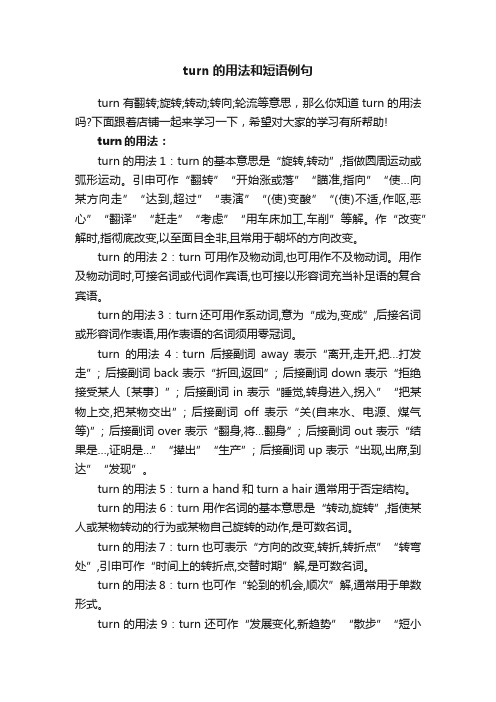
turn的用法和短语例句turn有翻转;旋转;转动;转向;轮流等意思,那么你知道turn的用法吗?下面跟着店铺一起来学习一下,希望对大家的学习有所帮助!turn的用法:turn的用法1:turn的基本意思是“旋转,转动”,指做圆周运动或弧形运动。
引申可作“翻转”“开始涨或落”“瞄准,指向”“使…向某方向走”“达到,超过”“表演”“(使)变酸”“(使)不适,作呕,恶心”“翻译”“赶走”“考虑”“用车床加工,车削”等解。
作“改变”解时,指彻底改变,以至面目全非,且常用于朝坏的方向改变。
turn的用法2:turn可用作及物动词,也可用作不及物动词。
用作及物动词时,可接名词或代词作宾语,也可接以形容词充当补足语的复合宾语。
turn的用法3:turn还可用作系动词,意为“成为,变成”,后接名词或形容词作表语,用作表语的名词须用零冠词。
turn的用法4:turn后接副词away表示“离开,走开,把…打发走”; 后接副词back表示“折回,返回”; 后接副词down表示“拒绝接受某人〔某事〕”; 后接副词in表示“睡觉,转身进入,拐入”“把某物上交,把某物交出”; 后接副词off表示“关(自来水、电源、煤气等)”; 后接副词over表示“翻身,将…翻身”; 后接副词out表示“结果是…,证明是…”“撵出”“生产”; 后接副词up表示“出现,出席,到达”“发现”。
turn的用法5:turn a hand和turn a hair通常用于否定结构。
turn的用法6:turn用作名词的基本意思是“转动,旋转”,指使某人或某物转动的行为或某物自己旋转的动作,是可数名词。
turn的用法7:turn也可表示“方向的改变,转折,转折点”“转弯处”,引申可作“时间上的转折点,交替时期”解,是可数名词。
turn的用法8:turn也可作“轮到的机会,顺次”解,通常用于单数形式。
turn的用法9:turn还可作“发展变化,新趋势”“散步”“短小节目”“风格,性格,性情,习性”等解,是可数名词,常与不定冠词a连用。
turn的用法和固定搭配示例

turn的用法和固定搭配示例【知识语文团队精选文章】TURN的用法与固定搭配示例专题一:TURN的基本用法1. Turn作为动词,表示“旋转、转动”。
例如:- I turned the key, but the door didn't open.我转动钥匙,但门没有打开。
- The car turned the corner quickly.小汽车迅速转过了拐角。
2. Turn还可以表示“改变方向”。
例如:- Can you turn left at the traffic lights?你能在红绿灯处向左拐吗?- The river turns sharply to the right here.河流在这里急剧转向右边。
3. Turn还可用作“变成、变为”的意思。
例如:- The caterpillar will soon turn into a butterfly.毛毛虫很快会变成蝴蝶。
- His dreams turned into reality.他的梦想成为了现实。
4. Turn用作名词,表示“轮流、机会、次序”等意思。
例如:- It's my turn to speak now.现在轮到我说了。
- As a leader, he had his turn to make decisions.作为领导,轮到他做决定。
专题二:TURN的固定搭配1. Turn a blind eye (to):故意不理睬、视而不见例如:- The police officer turned a blind eye to the illegal parking.警官对非法停车视而不见。
- The teacher turned a blind eye to the studentscheating on the exam.老师对学生在考试中作弊睁一只眼闭一只眼。
2. Turn the tables:扭转局势、转败为胜例如:- Our team turned the tables and won the game.我们的团队扭转了局势,赢得了比赛。
英语turn语法
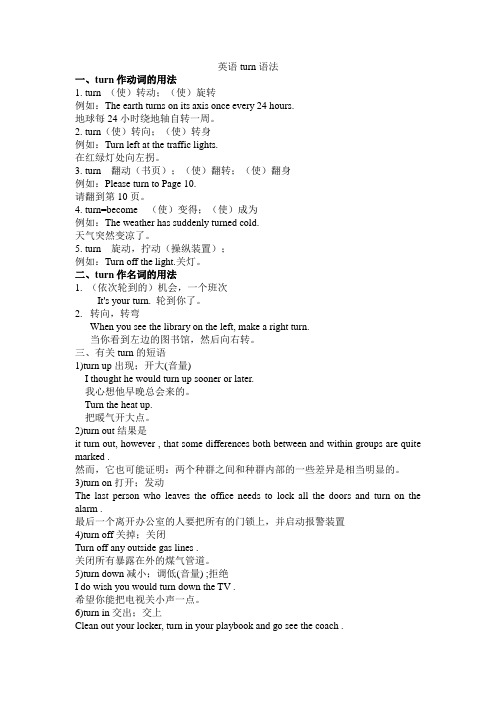
英语turn语法一、turn作动词的用法1. turn (使)转动;(使)旋转例如:The earth turns on its axis once every 24 hours.地球每24小时绕地轴自转一周。
2. turn(使)转向;(使)转身例如:Turn left at the traffic lights.在红绿灯处向左拐。
3. turn 翻动(书页);(使)翻转;(使)翻身例如:Please turn to Page 10.请翻到第10页。
4. turn=become (使)变得;(使)成为例如:The weather has suddenly turned cold.天气突然变凉了。
5. turn 旋动,拧动(操纵装置);例如:Turn off the light.关灯。
二、turn作名词的用法1. (依次轮到的)机会,一个班次It's your turn. 轮到你了。
2. 转向,转弯When you see the library on the left, make a right turn.当你看到左边的图书馆,然后向右转。
三、有关turn的短语1)turn up出现;开大(音量)I thought he would turn up sooner or later.我心想他早晚总会来的。
Turn the heat up.把暖气开大点。
2)turn out结果是it turn out, however , that some differences both between and within groups are quite marked .然而,它也可能证明:两个种群之间和种群内部的一些差异是相当明显的。
3)turn on打开;发动The last person who leaves the office needs to lock all the doors and turn on the alarm .最后一个离开办公室的人要把所有的门锁上,并启动报警装置4)turn off关掉;关闭Turn off any outside gas lines .关闭所有暴露在外的煤气管道。
turn短语用法总结

turn短语用法总结“turn”是一个常见的动词,在英语中有很多与之相关的短语,以下是几个常见的用法总结:1. turn on/off:打开/关闭。
例如:turn on the light(打开灯);turn off the TV(关闭电视)。
2. turn up/down:调高/调低。
例如:turn up the volume(把声音调大);turn down the heat(把温度降低)。
3. turn into:变成。
例如:The caterpillar turned into a butterfly(毛毛虫变成了蝴蝶)。
4. turn out:结果是。
例如:It turned out that he was telling the truth(结果他说的是实话)。
5. turn around:转身/掉头。
例如:She turned around and walked away(她转身离开了);The car turned around and drove back(车掉头返回了)。
6. turn over:翻转。
例如:Turn over the pancake(把煎饼翻面)。
7. turn to:求助于/转向。
例如:I turned to my friend for help(我向朋友求助);The ship turned to port(船向左拐)。
8. turn in:归还/上交。
例如:I turned in my homework to the teacher(我把作业交给了老师);The thief turned himself in to the police(小偷自首了)。
总之,“turn”是一个非常常见的动词,它可以与很多介词和副词组成不同的短语,表示不同的意思,需要根据具体语境进行理解。
- 1、下载文档前请自行甄别文档内容的完整性,平台不提供额外的编辑、内容补充、找答案等附加服务。
- 2、"仅部分预览"的文档,不可在线预览部分如存在完整性等问题,可反馈申请退款(可完整预览的文档不适用该条件!)。
- 3、如文档侵犯您的权益,请联系客服反馈,我们会尽快为您处理(人工客服工作时间:9:00-18:30)。
turn的用法
一、turn 用作名词时,意为“轮流”“依次轮流的顺序”。
例如:
Now it’s your turn to read the text. 现在轮到你读课文了。
It's my turn to use the bike. 该轮到我用自行车了。
You must stand in line and wait for your turn. 你必须排队等候。
含turn 的短语有: take turns 意为“替换”“轮流”; by turns 意为“轮流地”。
例如: Please take turns to ask questions. 请轮流提问。
We looked after the little boy by turns. 我们轮流照看这个小男孩。
We take turns to make dinner. 我们轮流做晚饭。
(=We make dinner by turns.)
注:take one's turn to do sth. = do sth. in turn =do sth. by turns轮流做某事
=take turns to do sth.=take turns at doing sth.=take turns doing sth.
The nurses attended the patient in turn / by turns. =The nurses took turns to attend the patient. Th e twins take turns to make dinner.
=The twins take turns at making dinner.
=The twins take turns making dinner.
二、turn 用作系动词时,意为“变得”。
例如:
In spring the trees turn green and the flowers start to come out. 春天,树变绿了,花儿开了?
In autumn the leaves turn yellow. 秋天树叶变黄。
She turned pale. 她的脸变得苍白。
三turn 用作不及物动词时,意为“转向”“翻转”.
turn right / left = turn to the right / left
例如:
Turn right. At the end of the road you’ll see the hospital. 向右拐,在路的尽头就是那家医院? Just go straight and turn left. 一直往前走,然后向左拐?
Turn to Page 12 in your workbook. 翻到练习册第12页?
He turned his face to the wall. 他转过脸面向墙壁。
The road turns south outside town. 此路在城外转弯向南。
turn to sth. / sb. (for help)
When I am in difficulty, I always turn to him for help. 我有困难时总是找他帮忙。
四、转动,旋转
The wheel turns when its axis moves. 轮轴动时,轮子也跟着转动。
He turned the key in the lock. 他旋动插进锁里的钥匙。
五、使倒置,使颠倒;倾倒[O]
He turned the glass upside down. 他将玻璃杯子倒置。
六、turn 可以和介词或副词一起构成短语动词,表达不同的意思?常见的这些短语动词有:
1. turn over 意为“翻过来”例如:
Tom turned over the note and read, “Come and look for me in the study.” 汤姆把便条翻过来读道,“到书房来找我.”
2. turn on 意为“打开(灯?收音机?电视机等)”?例如:
Please turn on the blender. 请打开果汁机?
I turned on the radio. The little girl stopped crying. 我打开收音机,这小女孩不哭了?
3. turn off 意为“关上(灯?收音机?电视机等)”例如:
Please turn off the TV set. 请把电视机关掉?
Please remember to turn off all the lights when you leave. 请记住离开时一定把所有的灯都关掉.
4. turn down/up 意为“调低/高(音量)”?例如:
Could you turn your radio down, please? 你能把收音机的音量调低一点儿吗?
Please turn the radio up. 请把收音机的音量调高一些?
5. turn into变成
Water has turned into ice. 水已经结成了冰。
turn ... into ... (使……)成为……
The farmers are turning waste land into rice fields.
6. turn over (使)打翻 / 翻身 / 翻动 / 翻耕(土地) / 转危为安
The man turned over and went to sleep again when the telephone rang.
7. turn in 上交
The child picked up a purse on the way and turned it in to the policeman.
补:8. turn out 结果是 / 证明是 / 生产出
The weather yesterday turned out (to be) fine.
The factory turned out more products than they had expected.
9. turn from side to side 把身体转来转去
The naughty boy turned from side to side while answering questions in class.
10. turn up 开大 / 出现 / 找到 / 证明是 (= turn out to be)
The meeting is beginning, but he has not turned up. He might have been lost.
11.turn against 背叛
Nobody will turn against his country.
He turned against his former friends. 他转而与以前的朋友作对。
He tried to turn my friends against me. 他试图使我的朋友反对我。
[练习] 从ABCD中选择最佳答案.
1. —Do you mind if I ________ the TV a bit?
—Yes, I do, because I’m busy with my homework now.
A. turn on
B. turn up
C. turn down
D. turn off
2. The lights must be________ before you leave the classroom.
A. turned on
B. turned up
C. turned down
D. turned off
3. Don’t________ the radio. The baby is sleeping.
A. turn off
B. turn on
C. turn over
D. turn down
4. How magnificent the Bund looks at night when all the lights are________ !
A. turned over
B. turned off
C. turned down
D. turned on
5. —Her radio is too loud, isn’t it?
—Yes. Let me tell her to________ .
A. turn it up
B. turn up it
C. turn it down
D. turn down it
6. —The radio is too n oisy and there is nothing interesting on it. Why don’t you________ ?
—All right. I’ll do that.
A. turn it on
B. turn it off
C. turn it back
D. turn it up
Key: 1. B2. D3. B4. D5. C6. B
易错题:
Ten years later, he turned teacher.
A. /
B. a
C. an
D. the
注:此题考查turn 作连系动词的特殊用法,即 turn 作连系动词时后接表语名词,省略冠词.所以此题的答案为A. 如果turn 后加into 则须在名词前加冠词a.。
